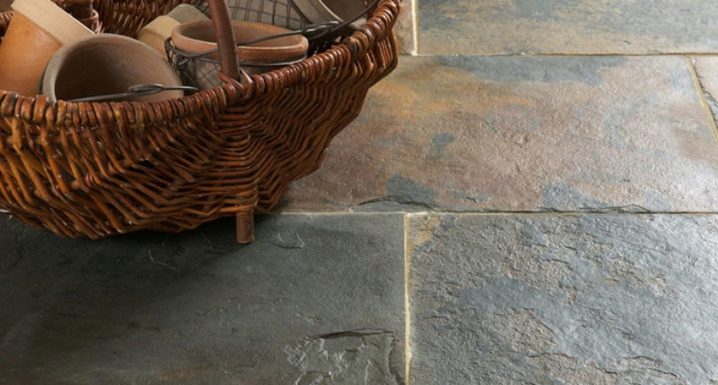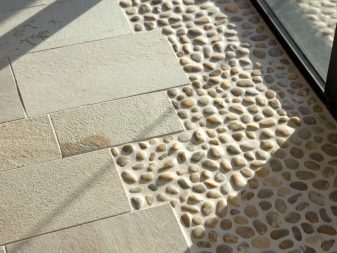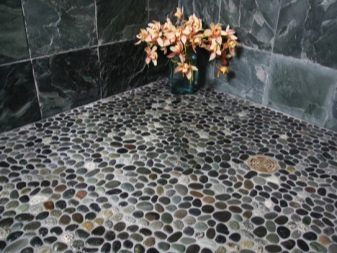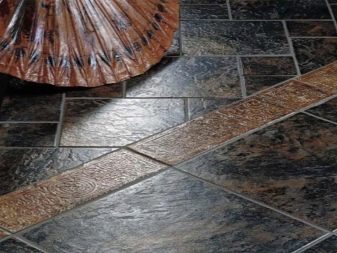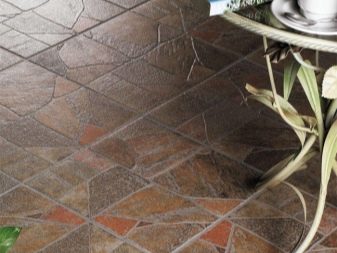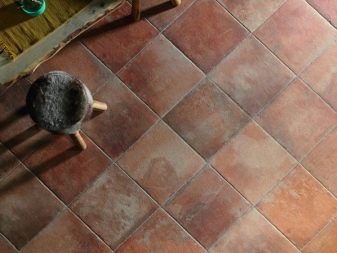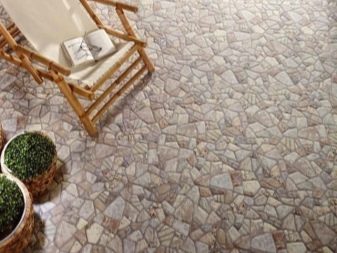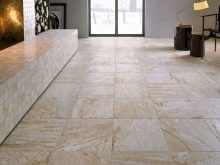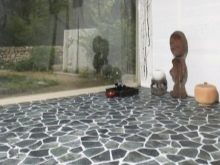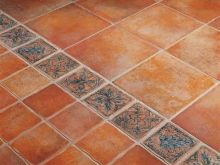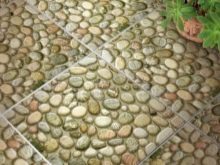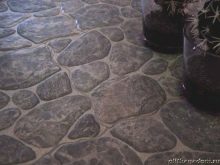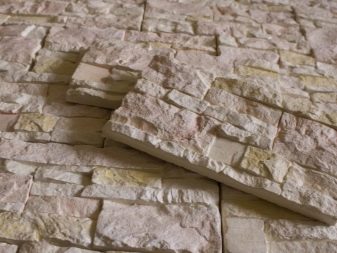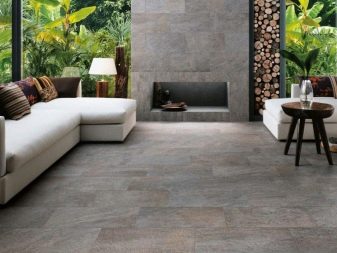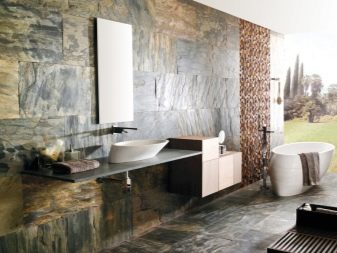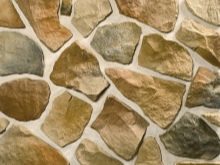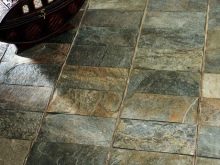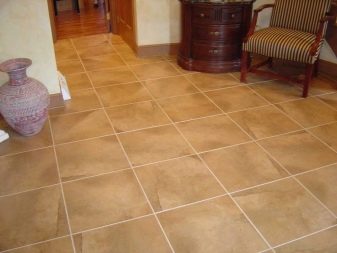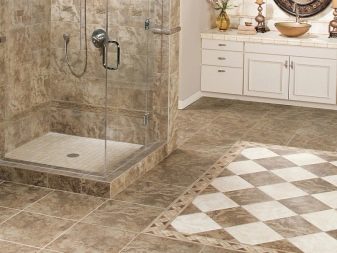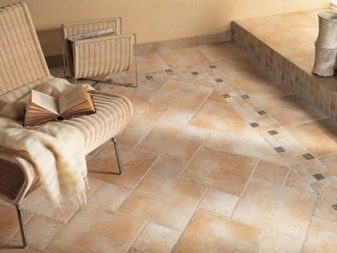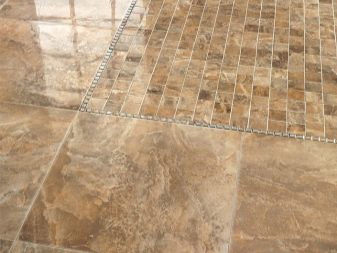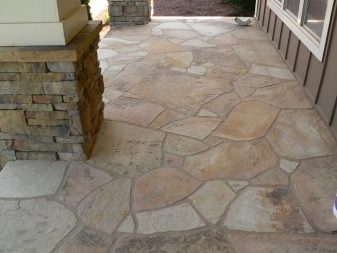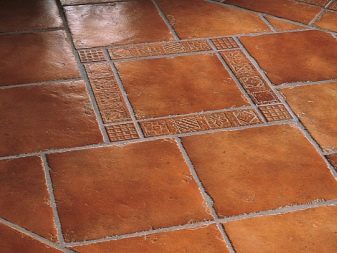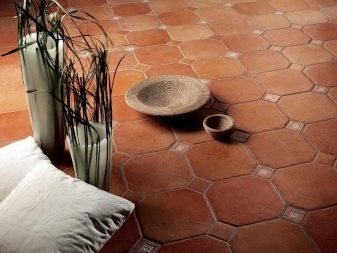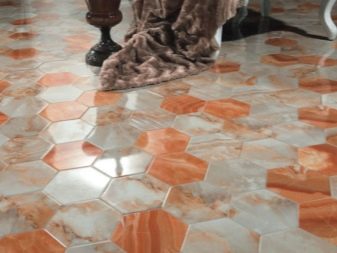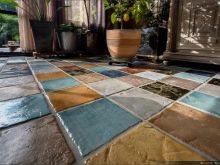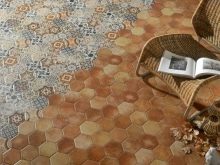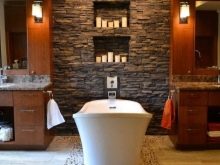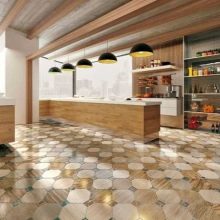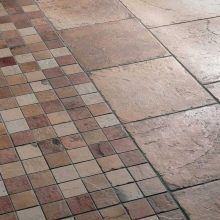Floor tiles under the stone: original floor design ideas
Finishing the floor - an important component of the interior room. The stone sawn into individual slabs serves as an excellent finishing material. This is a very beautiful material that looks expensive and can be applied in different rooms: residential building, apartment, office.
But he has flaws - incredibly expensive, can crumble and absorb moisture. And not everyone can afford such a finish. In this case, ceramic tile that imitates an elastic stone comes to the rescue.
Features and types
Tile under the stone has a heterogeneous pattern inherent in natural rocks, veinlets, porosity. The tile is easy to install, unlike stone; it is much lighter than stone slabs.It is easy to exploit because it is fired. It is environmentally friendly and does not react with household detergents.
Withstands the effects of water and rainfall, so varieties of flooring can be used for outdoors. Floor tiles retain their appearance for a long time, unlike stone, which can wear out.
To date, there are several types of tiles that mimic the stone coating:
- The brick tile - happens glazed and not glazed. Used for wall and floor cladding. Very resistant to moisture, so suitable for outdoors, wet rooms in the house, swimming pools. It can be of any geometric shape and color, so it opens up wide opportunities for decorative interior decoration.
- Porcelain tile - does not absorb moisture at all. It has the appearance of a wild stone, as it is created by semi-dry pressing. Ideal for wet rooms, as it allows you to collect a large amount of moisture, even in case of accidents. It has a wide range of colors.
- The tile imitating a stone - smooth, has beautiful drawings of stone breeds.It has all the advantages of tile, but when wet it can be slippery. Its glazed coating may fade or fade over time. Not very well withstand the load, with the fall of the object may crack.
- PVC tile is a synthetic material that is produced by individual tiles. It has a number of both advantages and disadvantages. The PVC tile is moisture resistant, it is easily glued and creates a warm floor. But not too resistant to household chemicals and not very environmentally friendly, as it is a synthetic material.
- The cotto tile is made from red clay without glaze, therefore in its range mainly shades of red ceramics. Suitable for flooring in different areas of the house, including where there is moisture.
- Majolica - ceramic tiles with painting. Have a strong decorative effect in the interior.
- Pebbles and pebble tiles. Pebbles are rounded pebbles, which are obtained as a result of their treatment with waves on the shore. To make the floor more evenly, a mosaic is produced in the form of rounded tiles imitating pebbles, but with a smooth surface.
- Wild stone - imitation of torn stone. Natural stone can injure a person.Tile, made in the form of a rough stone, will not be able to cause cuts, as it is molded from the clay mass and is fired. Therefore, its use is much better than natural stone.
- Gypsum tiles are not sensitive to moisture and under its influence may begin to deteriorate. Therefore, it should not be used in rooms with high humidity. And for the floor in the hallway, living room, office, it is quite suitable.
You can also protect it with a water-repellent coating, better varnish, and then the gypsum tile will serve for a long time, keeping its appearance and pleasing the hosts.
Application
Designer use of natural stone floor tiles is very wide. The stone is so versatile with its streaks and divorces that it fits into the interior of any style - from classic to antiquity and hi-tech.
Natural flexible stone can be used on walls and floors to create the effect of a durable stone house. But you should not finish all surfaces with imitation of natural stone. Otherwise the rooms will become cold in perception.
The best option is to select some planes, which will become an accent in the form of a natural stone.It can be a fireplace, a window, a fragment of a wall on which some important element of the interior hangs.
Drawing for the floor must necessarily be combined or repeated drawing of a stone on the wall. Then the room will be more solid. Paving options on the floor can be very different, depending on the idea of the interior.
The size
The size of the tiles from different manufacturers varies widely. It depends on the general idea, which floor slabs should choose - large or small. For larger rooms, it is better to choose a larger tile, since small mosaics will be lost in space. They can be used as a fragment.
And if there is a desire to fill all the spacious premises with small squares, then the drawing should not be dazzling, it is necessary to have monochromatic parts in it. For smaller rooms, it is better to choose smaller ceramics. But they look great mosaic of small elements.
Layout techniques
Among the main options for laying the plates are the following.
The simplest paving on the floor - parallel to the walls. Such plates for interior decoration can be laid out with a slide, which will already create an interesting pattern of seams.Places can be entered strip with an ornament of the same color, which will create a more refined image of the room. If the polyurethane tile is square, then the squares from the “wild stone” can be interleaved with narrow ornamental or mosaic stripes.
In a large room in this way you can lay out large cells - squares of four tiles. And to separate them from each other with thin mosaic stripes, in which dark and light squares emphasize the beauty of the fragments of the “wild stone”.
The second floor design option is unfold the tiles diagonally, joining the walls at a 45 degree angle. This technique can be used when placing tiles throughout the room, a diagonal direction will revive the room. You can also combine them with tiles laid parallel to the walls. When laying it will be necessary to cut ceramics, but the combination of directions will diversify the surface of the floor and provide an opportunity to play with its design.
Tiles of different directions can also be combined with ornamental or mosaic stripes. The diagonal part can be laid out in the form of a carpet with a border, thus separating the important area of the room, the center of the room or the location of the table with chairs. Long tiles can be laid “herringbone” on the floor like parquet.
Some companies produce slabs of irregular shapes that imitate pieces of stones, but they are ideally combined with each other during installation without causing problems. You can also use pebbles, both purchased and hand-made on the beach.
Natural pebbles usually have a curved surface, so that it was convenient to walk, they lay out part of the floor.
Alternatively, you can make a rug of pebbles over the floor and stomp on it by massaging your feet. And some companies produce tiles that mimic pebbles, but with a smooth surface.
There is also a set of plates, which combines ceramics of different sizes. These can be large rectangles that are laid out with a herringbone, and small squares are placed in between. Or large diagonal squares, on the connection of which tiny squares of a different color are laid. There are even sets where there can be up to three or four kinds of geometric shapes.
Now produced and curly tiles of complex configurations in different colors. Hexagons are popular both in regular geometric shapes and in combination with intermediate squares.This floor is very original, the tiles are made so that they are ideally suited to each other.
But the calculation of their quantity for the surface can cause difficulties, so it is worth contacting a specialist in order not to be mistaken in quantity.
Color solutions
The color of the tile depends on the overall design of the interior. Light shades increase the room, so more suitable for small rooms. Dark - reduce, so they can be used in large spaces.
You can play with tiles that mimic natural stone of different colors. It will enrich the interior. You can combine different textures - natural stone and ornaments or mosaics. Part of the room, which differs in function, to highlight other tiles, connecting in the design of the floor are often opposite colors - light and dark.
So, it is possible to separate the area where the equipment in the kitchen is located from the dining room, the corner of the bathroom and the shower from the rest of the room. You can apply light and dark tiles in a staggered manner for both parallel and diagonal layouts. This coating will be very bright, so the rest of the interior should complement it.
Interesting options
The combination of opposite design tiles looks extremely interesting. It can be:
- Wild stone and patterned borders or mosaic;
- brilliant and matte tiles under a natural stone of the same color;
- a set of geometrically correct or irregular tiles of different sizes;
- arrangement of tiles at different angles - a combination of a “fir-tree” or diagonal with a direction parallel to the walls;
- large and small items;
- chess - alternating tiles of two colors;
- several colors in the layout of the plates at the same time.
If the interior is more monotonous, then you can play with the floor, laying a complex configuration of tiles, using a variety of color, a combination of textures, "carpets", curbs, rich colors, complex compositions and color spots.
The advantages of ceramic granite compared to natural stone are described in the video below.
